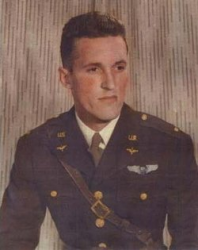
 |
|
|
||
|
Raymond Harrell Wilkins |
||||
|
Engagements: • World War II (1941 - 1945) |
||||
| Biography: | ||||
|
Raymond Harrell Wilkins Major, U.S. Army Air Forces Medal of Honor Recipient World War II Major Raymond H. Wilkins (28 September 1917 - 2 November 1943) was a U.S. Army Air Forces officer and pilot who was posthumously awarded the U.S. military's highest award for valor, the Medal of Honor, for his heroic actions during World War II. Raymond H. Wilkins was born on 28 September 1917 in Portsmouth, VA; he also joined the Army from his birth city. Wilkins entered the University of UNC-CH from Columbia High School in 1934 and studied chemistry and pharmacy until December 1935. He entered the U.S. Army Air Corps in 1936. He won his pilot wings and his commission and was an instructor at Kelly Field, TX. On 2 November 1943, he had risen to the rank of Major and was in command of the 8th Bombardment Squadron of the 3rd Attack Group; he had flown 50 combat missions. On that day, he participated in a bombing raid on enemy ships in a harbor near Rabaul, New Britain. Wilkins repeatedly exposed himself to intense anti-aircraft fire and successfully destroyed two enemy vessels. Despite severe damage to his aircraft, he continued to attack until his plane was shot down into the sea, killing him. For his actions during the mission, he was posthumously awarded the Medal of Honor. Medal of Honor Rank and organization: Major, U.S. Army Air Corps. Place and date: Near Rabaul, New Britain, 2 November 1943. Citation: For conspicuous gallantry and intrepidity above and beyond the call of duty in action with the enemy near Rabaul, New Britain, on 2 November 1943. Leading his squadron in an attack on shipping in Simpson Harbor, during which intense antiaircraft fire was expected, Maj. Wilkins briefed his squadron so that his airplane would be in the position of greatest risk. His squadron was the last of 3 in the group to enter the target area. Smoke from bombs dropped by preceding aircraft necessitated a last-second revision of tactics on his part, which still enabled his squadron to strike vital shipping targets, but forced it to approach through concentrated fire, and increased the danger of Maj. Wilkins' left flank position. His airplane was hit almost immediately, the right wing damaged, and control rendered extremely difficult. Although he could have withdrawn, he held fast and led his squadron into the attack. He strafed a group of small harbor vessels, and then, at low level, attacked an enemy destroyer. His 1,000 pound bomb struck squarely amidships, causing the vessel to explode. Although antiaircraft fire from this vessel had seriously damaged his left vertical stabilizer, he refused to deviate from the course. From below-masthead height he attacked a transport of some 9,000 tons, scoring a hit which engulfed the ship in flames. Bombs expended, he began to withdraw his squadron. A heavy cruiser barred the path. Unhesitatingly, to neutralize the cruiser s guns and attract its fire, he went in for a strafing run. His damaged stabilizer was completely shot off. To avoid swerving into his wing planes he had to turn so as to expose the belly and full wing surfaces of his plane to the enemy fire; it caught and crumpled his left wing. Now past control, the bomber crashed into the sea. In the fierce engagement Maj. Wilkins destroyed 2 enemy vessels, and his heroic self-sacrifice made possible the safe withdrawal of the remaining planes of his squadron. Medals and Awards Medal of Honor Death and Memorial Major Raymond H. Wilkins was killed in action on 2 November 1943. His body was lost at sea and never recovered. Major Raymond H. Wilkins' name is inscribed on the Tablets of the Missing at the Manila American Cemetery and Memorial in Manila, Manila City, Philippines. A memorial headstone was also placed at Olive Branch Cemetery in his hometown of Portsmouth, VA, in Section F. |
||||
| Honoree ID: 1714 | Created by: MHOH | |||
Ribbons
Medals
Badges
Honoree Photos
 |  |  |
 |  |
 |


